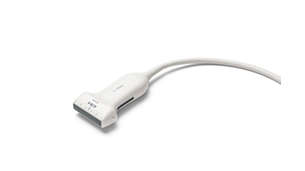Next Gen Auto Scan
Improves image uniformity
Philips Next Gen Auto Scan improves image uniformity, adaptively adjusting image brightness at every pixel and reducing the need for user adjustment while also improving transducer plunkability. Next Gen Auto Scan reduces button pushes by up to 54% with pixel-by-pixel real-time optimization1
Features

Automatic optimization
Next Gen Auto Scan automatically optimizes gain and time gain compensation (TGC) to continuously provide an optimal image without requiring users to manually adjust TGCs throughout the exam. The algorithm amplifies details in the raw ultrasound data that would be difficult to visualize with conventional image compression.

Image brightness adaptation
One challenge with rendering ultrasound images consists of mapping the high dynamic range (HDR) of the raw data to a display monitor that has a much lower standard dynamic range (SDR). Poor image compression can result in the loss of clinical information at both the highlights and shadows. Next Gen Auto Scan’s robust algorithm overcomes this challenge by adaptively adjusting image brightness at every pixel.

High stability across patients
Conventional image compression requires the user to manually adjust images to the desired brightness both axially and laterally using multiple gain controls. This approach requires constant adjustments by the user, depending on the body habitus. Next Gen Auto Scan’s automatic adjustments delivers high stability across patients - including technically difficult patients - while requiring fewer manual adjustments. This allows sonographers to move more easily from patient to patient, improving workflow.
Image gallery
- Toggle view

EPIQ Elite
Philips EPIQ Elite ultrasound features an exceptional level of clinical performance, workflow and advanced intelligence to meet the challenges of today’s most demanding practices. These Philips ultrasound machines bring ultimate solutions to ultrasound, with clinically tailored tools designed to elevate diagnostic confidence to new levels.
Next Gen Auto Scan technology is available on
-
eL18-4 Transducer
The eL18-4 transducer is an ultra high-frequency linear transducer that incorporates ultra-broadband PureWave crystal technology with fine-elevation focusing capability, generating ultra-broadband frequencies from 2 to 22 MHz. The transducer’s advanced design allows for wide field-of-view trapezoid imaging and superb 2D detail resolution. It supports a broad range of high resolution applications including breast, small parts, vascular, pediatric and musculoskeletal imaging along with the penetration needed in obstetrical and gynecological examinations to help elevate clinical confidence.
453561780782 -
C5-1 Transducer
The C5-1 PureWave curved array transducer with 5 to 1 MHz extended operating frequency range is ideal for high performance Fetal Echo, Abdominal, Interventional, and OB/GYN applications. It offers exceptional clinical performance for a wide range of patient types including obese and technically challenging patients.
989605412041 -
L12-3ERGO Transducer
The Philips L12-3ERGO transducer is designed to increase comfort while scanning, specifically for longer periods of use. It includes a new ergonomic form factor and is lighter than the L12-3. The changes made to the transducer include, increased texture on the handle, more pronounced ledge, flatter housing at the nose and ruler lines at the top. Learn more about the L12-3ERGO broadband linear array transducer in the specification table below.
989605492481 -
L12-3 Transducer
Learn more about the Philips L12-3 broadband linear array transducer in the specification table below.
989605412071 -
S5-1 Transducer
The S5-1 transducer with PureWave technology generates extended operating frequency range from 5 to 1 MHz. It supports imaging in 2D, contrast mode, coronary color, CW & PW Doppler, steerable pulsed wave, High-PRF, color doppler, tissue doppler and biopsy guide capabilities. It uses reoptimized xRes adaptive image processing to provide refined tissue pattern displays, with improved details, better edges and fine border definition. It supports adult echo, abdominal, pediatric echo and TCD applications.
989605412081
Documentation
- Clinical articles
-
Footnotes
1 When comparing release 10 to release 7. Based on a small number of samples (n≤20); not statistically powered.





